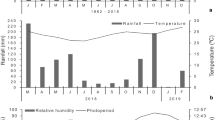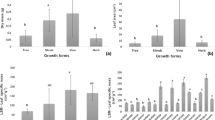Abstract
Plants of Lythrum salicaria and Phragmites australis originating from localities across the European north–south geographical gradient were cultivated in parallel in an outdoor tub experiment. A strong correlation was found between growth and morphometric characteristics related to plant size (plant height, basal diameter, aboveground- and belowground plant biomass, etc.) and the position of the respective populations along the north–south gradient. Plants of both L. salicaria and P. australis from the southern localities grew taller and more vigorously and flowered later than plants from relatively more northern localities. From this point of view, the plants originating from south European populations were comparable to invasive North American plants. Our study indicates that explanation of the competitive success of populations invading new geographical areas may involve the role of geographic gradients within the species native range.
Similar content being viewed by others
References
D. Bastlová-Hanzélyová (2001) Comparative study of native and invasive plants of Lythrum salicaria L.: population characteristics, site and community relationships G. Brundu J. Brock I. Camarda L. Child M. Wade (Eds) Plant Invasions: Species Ecology and Ecosystem Management SPB Academic Publishing Amsterdam, The Netherlands 33–41
D. Bastlová J. Květ (2002) ArticleTitleDifferences in dry weight partitioning and flowering phenology between native and non-native plants of purple loosestrife (Lythrum salicaria L.) Flora 197 332–340
Bastlová, D., H. Čížková, M. Bastl & J. Květ, 2004. Growth of Lythrum salicaria and Phragmites australis plants originating from a wide geographical area: response to nutrient and water supply. Global Ecology and Biogeography 13: 259–271
B. Blossey R. Nötzold (1995) ArticleTitleEvolution of increased competitive ability in invasive nonindigenous plants: a hypothesis The Journal of Ecology 83 887–889 Occurrence Handle10.2307/2261425
O. A. Clevering H. Brix J. Lukavská (2001) ArticleTitleGeographical variation in growth responses in Phragmites australis The Aquatic Botany 69 89–108 Occurrence Handle10.1016/S0304-3770(01)00132-2
F. di Castri A. J. Hansen M. Debussche (1990) Biological Invasions in Europe and the Mediterranean Basin Kluwer Academic Publishers Dordrecht
Dubyna, D. V., S. Hejný & Z. Hroudová (eds), 1993. Macrophytes as Indicators of Environmental Changes. Naukova Dumka, Kiev (In Russian)
K. R. Edwards M. S. Adams J. Květ (1998) ArticleTitleDifferences between European native and American invasive populations of Lythrum salicaria Applied Vegetation Science 1 267–280 Occurrence Handle10.2307/1478957
K. R. Edwards M. S. Adams J. Květ (1999) ArticleTitleComparison of Lythrum salicaria L. study sites in the Midwestern U.S. and central Europe Ekológia (Bratislava) 18 113–124
S. M. Haslam (1972) ArticleTitle Phragmites communis Trin. Biological Flora of the British Isles The Journal of Ecology 60 585–610 Occurrence Handle10.2307/2258363
S. M. Haslam (1973) ArticleTitleSome aspects of the life history and autecology of Phragmites communis Trin. A review Polish Archives of Hydrobiology 20 79–100
K. J. Havens I. P. Walter B. Harry (1997) ArticleTitleInvestigation and long-term monitoring of Phragmites australis within Virginia’s constructed wetland sites Environmental Management 21 599–605 Occurrence Handle9175546 Occurrence Handle10.1007/s002679900052
S. Hejný (1960) Ökologische Charakteristik der Wasser- und Sumpfpflanzen in den Slowakischen Tiefebenen (Donau- und Theissgebiet) Slovac Academy Press London 487
L. Jouve Y. Charron C. Couderc H. Greppin R. Degli Agosti (1998) ArticleTitleDependence of Arabidopsis thaliana floral stem growth and architecture on photoperiod Biologia Plantarum 41 377–386 Occurrence Handle10.1023/A:1001894226251
H. Kudoh Y. Ishiguri S. Kawano (1995) ArticleTitlePhenotypic plasticity in Cardamine flexuosa: variation among populations in plastic response to chilling treatment and photoperiod Oecologia 103 148–156 Occurrence Handle10.1007/BF00329074
B. Li J. I. Suzuki T. Hara (1998) ArticleTitleLatitudinal variation in plant size and relative growth rate in Arabidopsis thaliana Oecologia 115 293–301 Occurrence Handle10.1007/s004420050519
M. Marks L. Beth J. Randall (1994) ArticleTitle Phragmites australis (P. communis): threats, management, and monitoring Natural Areas Journal 14 285–294
P. McCullagh J. A. Nelder (1989) Generalized linear models, EditionNumber2 Chapman and Hall London, UK
H. A. Mooney J. A. Drake (1986) Ecology of Biological Invasions of North America and Hawaii Springer-Verlag New York 321
J. T. Peacock C. McMillan (1968) ArticleTitleThe photoperiodic response of american Prosopis and Acacia from broad latitudinal distribution American Journal Botany 55 153–159 Occurrence Handle10.2307/2440446
H. Pollard M. Cruzan M. Pigliucci (2001) ArticleTitleComparative studies of reaction norms in Arabidopsis. I. Evolution of response to daylength Evolutionary Ecology Research 3 129–155
Rodewald-Rudescu L., 1974. Das Schilfrohr. Phragmites communis Trin. Die Binnengewässer, Vol. 27. Schweizerbart’sche Verlagsbuchhandlung, Stuttgart
K. Saltonstall (2002) ArticleTitleCryptic invasion by a non-native genotype of the common reed, Phragmites australis, into North America Proceedings of the National Academy of Sciences of the United States of America 99 2445–2449 Occurrence Handle11854535 Occurrence Handle1:CAS:528:DC%2BD38XitVSqsro%3D Occurrence Handle10.1073/pnas.032477999
S. R. A. Shamsi F. H. Whitehead (1974) ArticleTitleComparative eco-physiology of Epilobium hirsutum L. and Lythrum salicaria L. I. General biology, distribution and germination The Journal of Ecology 62 279–290 Occurrence Handle10.2307/2258893
Statistical Sciences, 1995a. S-PLUS Guide to statistical and mathematical analysis, Version 3.3 for Windows. StatSci, a division of Mathsoft, Inc., Seattle, Washington, USA
Statistical Sciences, 1995b. User’s manual, Version 3.3 for Windows. StatSci, a division of Mathsoft, Inc., Seattle, Washington, USA
R. L. Stuckey (1980) ArticleTitleDistributional history of Lythrum salicaria (purple loosestrife) in North America Bartonia 47 3–20
K. Véber (1978) Propagation, cultivation and exploitation of common reed in Czechoslovakia D. Dykyjová J. Květ (Eds) Pond Littoral Ecosystem. Structure and Functioning Springer-Verlag Berlin 416–425
E. Weber B. Schmid (1998) ArticleTitleLatitudinal population differentiation in two species of Solidago (Asteraceae) introduced into Europe American Journal of Botany 85 1110–1121 Occurrence Handle10.2307/2446344
A. J. Willis B. Blossey (1999) ArticleTitleBenign environments do not explain the increased vigour of non-indigenous plants: a cross-continental transplant experiment Biocontrol Science and Technology 9 567–577 Occurrence Handle10.1080/09583159929523
J. H. Zar (1984) Biostatistical Analysis Prentice-Hall, Inc., Englewood Cliffs New Jersey, USA
Author information
Authors and Affiliations
Corresponding author
Rights and permissions
About this article
Cite this article
Bastlová, D., Bastl, M., Čížková, H. et al. Plasticity of Lythrum salicaria and Phragmites australis growth characteristics across a European geographical gradient. Hydrobiologia 570, 237–242 (2006). https://doi.org/10.1007/s10750-006-0186-0
Issue Date:
DOI: https://doi.org/10.1007/s10750-006-0186-0




